A key genetic mutation—harmful in humans—may have opened the sky to bats
Bats have done something no other mammal ever has: the leathery-winged beasts evolved powered flight thanks to specialized membranes called patagia connecting their limbs and digits to the rest of their body. A new study of bat embryos in BMC Biology reveals a crucial step in how these once land-bound animals evolved to fly—and it may involve a gene known for detrimental mutations in humans.
Paleontologists have yet to discover fossils showing a transition to the earliest flying bats. But the embryonic development of today's living bats contains clues to these ancient changes.“The bat wing is a crazy amalgam of derived and novel anatomical elements,” says study author Karen Sears, a biologist at the University of California, Los Angeles. And the plagiopatagium, a specific patagium that connects the side of the body to the arms and legs, is among the most important.
During development, the researchers found, the plagiopatagium grows from the side of the fetus's body and merges with its limbs. This pattern held across all the species studied, indicating an ancestral wing. A mutation in a particular gene called Ripk4 may have enabled the change. “Evolution is unpredictable, and development is often modified in ways that we cannot, or do not, anticipate,” Sears says. In humans and laboratory mice, mutations to Ripk4 can alter the skin to create patagiumlike structures and cleft lips, among other issues. About half of all living bat species have cleft palates—a feature that may be tied to bat echolocation.
The findings provide important evidence for how skin layers fuse together to form bats' essential flight membrane, says University of Melbourne biologist Charles Feigin, who was not involved in the new study. This fusion makes the wings resilient enough for powered flight, Feigin says; similar, weaker membranes in other airborne mammals limit them to gliding. A chance mutation might have been the key that opened the sky to bats.
United States Latest News, United States Headlines
Similar News:You can also read news stories similar to this one that we have collected from other news sources.
 Widespread antibiotic resistance among cholera-causing bacteria explained by gene mixingScientists have identified the source of antibiotic resistance that emerged within bacteria driving the ongoing Yemen cholera epidemic.
Widespread antibiotic resistance among cholera-causing bacteria explained by gene mixingScientists have identified the source of antibiotic resistance that emerged within bacteria driving the ongoing Yemen cholera epidemic.
Read more »
 CRISPR-based gene editing gets smaller, better 'scissors'Adenoviruses used in gene editing experiments have reached their cargo carrying limits and smaller enzymes are crucial to make gene therapy a reality.
CRISPR-based gene editing gets smaller, better 'scissors'Adenoviruses used in gene editing experiments have reached their cargo carrying limits and smaller enzymes are crucial to make gene therapy a reality.
Read more »
 Amazing Advance in Spinal Repair Allows Injured Mice to Walk AgainResearchers have reversed 'irreversible paralysis' in mice with complete spinal cord injuries using gene therapy.
Amazing Advance in Spinal Repair Allows Injured Mice to Walk AgainResearchers have reversed 'irreversible paralysis' in mice with complete spinal cord injuries using gene therapy.
Read more »
 Chicago White Sox: Gene Watson takes over player personnelGene Watson described the role of director of player personnel with the Chicago White Sox as “just turning over every rock to find the best players we can.”
Chicago White Sox: Gene Watson takes over player personnelGene Watson described the role of director of player personnel with the Chicago White Sox as “just turning over every rock to find the best players we can.”
Read more »
 Heavy rainfall causes Randall’s Island tent facility for migrants to leak like a sieveVideos shared with Gothamist show rainwater entering from above and below. Residents used plastic garbage bags to stay dry.
Heavy rainfall causes Randall’s Island tent facility for migrants to leak like a sieveVideos shared with Gothamist show rainwater entering from above and below. Residents used plastic garbage bags to stay dry.
Read more »
